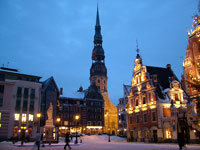 Riga OverviewThe enchanting city of Riga, capital of Latvia and the biggest
city in the Baltic States, has emerged from behind the Iron Curtain
and is slowly coming into its own as a major European tourist
destination. Situated on the south-western coast of the country,
Riga is split in two by the River Daugava, and served as a major
trading port and a crossroads between western Europe and the East.
The modern founding of the city dates back to the 12th Century with
the arrival of German traders, mercenaries and missionaries; while
its older roots date back to a settlement of the ancient Finnic
tribe, the Livs. The city, and Latvia as a whole, was long caught in a tug of war
between the Germans and the Russians, and suffered greatly in World
War II when roughly a third of the country's population was
exterminated, displaced or fled Nazi persecution. However, despite
this lamentable past, there are still plenty of things for tourists
to see and do in Latvia. Riga boasts a collection of exquisite Art Nouveau buildings that
rival those in Vienna, Barcelona and St Petersburg, and the
fairytale-like historic city centre is a delight to explore. As the
cultural and economic centre of the country, Riga is home to plenty
of top-class museums, galleries and performing arts centres, as
well as a range of sophisticated bars, clubs and restaurants. The
city is fast gaining a reputation as a party capital, and its
vibrant nightlife draws hundreds of weekenders from all over
Europe. For a more traditional Latvian experience, it is well worth
braving the winter cold to enjoy a spot of ice fishing, ice-skating
on the frozen Daugava River, or a
a rigorous sauna that involves being beaten with
dried birch branches. With over 800 years of history, a UNESCO
World Heritage Site-listed historic city centre and a modern buzz,
Riga remains a largely undiscovered gem with plenty to delight and
enchant the visitor. |